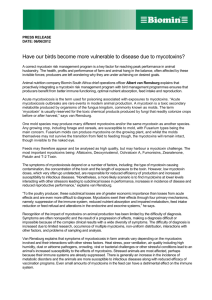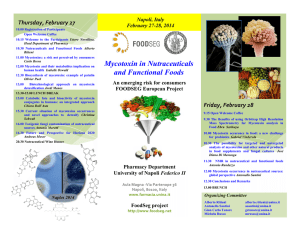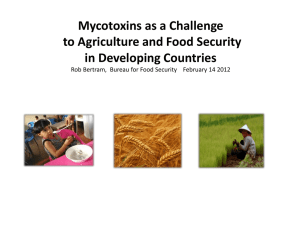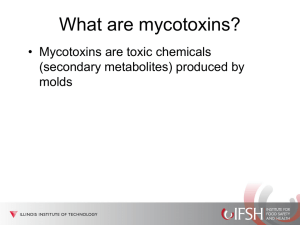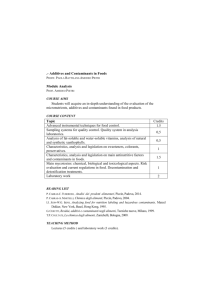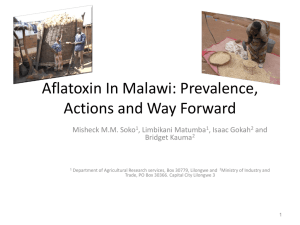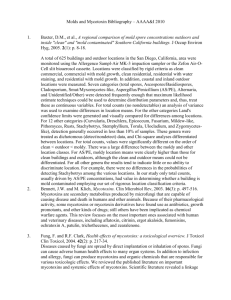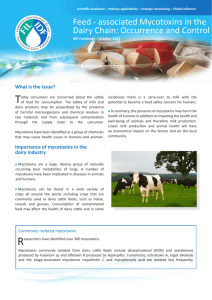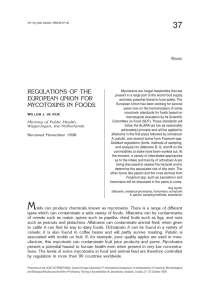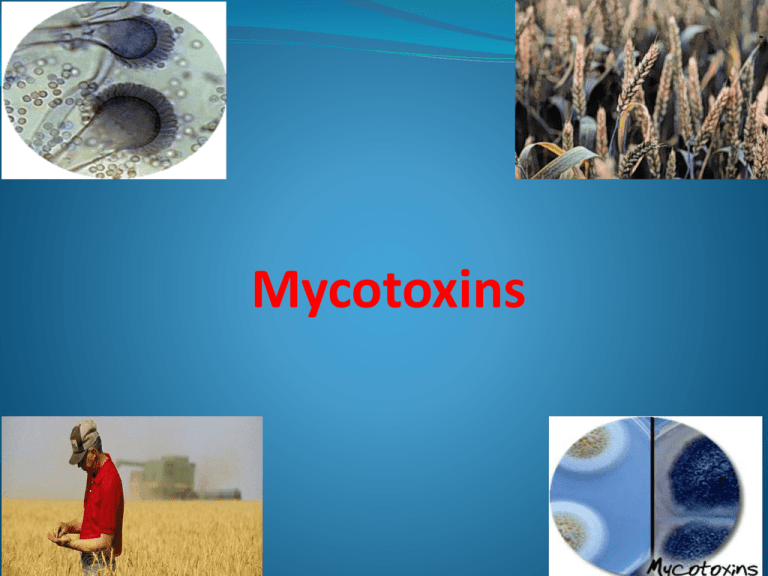
Mycotoxins
Mycotoxins are natural chemicals produced by certain
fungi(molds) which occur as contaminants of some food
crops, either in the field or during post-harvest storage.
Cereals, nuts, fruits and foods derived from these crops are
the most likely to contain mycotoxins. mycotoxins are toxic to
humans and animals
Three types of fungi are the major producers of mycotoxins –
Fusarium, Pencillium, Aspergillus. Within each type of fungus,
particular species may be mycotoxigenicor mycotoxinproducing
While hundreds of mycotoxins have been identified
from a very large number of fungi, only 20-30
mycotoxins have been associated with potential
toxicity to animals and humans
Aspergillus
penicillium
fusarium
Types of mycotoxins
There are over 300 mycotoxins but the commonly occurring
ones in food and feed. about 20 mycotoxins occur in food at
levels and frequency to be of food safety concern.
Common Members of the Mycotoxin Family
Aflatoxins, Fumonisin, Ochratoxins, Patulin, Zearalenone,
Fumonisins
Trichothecenes(Type A: DAS, T-2), Patulin, Moniliform,
Sterigmatocystin
Cyclopiazonic acid, Kojic acid, Maltoryzine, ßnitropropionic acid Aspergillic acid, Penicillic acid,
Roquefortine C
Common Members of the Mycotoxin Family
mycotoxin occurrence in foods
Mycotoxin is produced by a fungus under special conditions of
moisture and temperature in :
1- Mould damaged foodstuffs including agricultural products like
cereals, oilseeds, fruits and consumer foods such as peanut butter
2-Residues in animal tissues and products e.g. milk, meat, dairy
produce
3-Mould ripened foods e.g. cheeses, meats
4-Fermentation products e.g. microbial proteins and enzymes.
Juices e.g. apple juice
Mycotoxin Chain of Events
Aflatoxins
Toxins produced by the fungi Aspergillus flavus and
Aspergillus parasiticus
Four primary aflatoxins, named B1, B2, G1 and G2 plus
two additional metabolic products, M1 and M2.
Aflatoxins occur in nuts, cereals and rice under
conditions of high humidity and temperature and
present a risk to human and animal health
Aflatoxins: Human, Animal, and Environmental
Interactions
Environment:
extreme
drought,
moisture,
heat,
compromised
plants
Fungal
growth /
aflatoxin
production
Contamination
of human &
animal food
Human
consumption
Breast milk
In utero
Animal
consumption
Mechanism of toxicologic damage
Because of aflatoxins’ common occurrence in feedstuffs, feeds
and milk products. Although the oral route is the main
contamination means, inhalation may also occur as a result of
people or animals being exposed to the grains’ dust. After
respiratory exposure, AfB1 may appear in the blood more quickly
than after oral exposure. Nevertheless,. Following ingestion,
aflatoxin B1 is efficiently absorbed in the intestinal tract, of which
the duodenum appears to be the major site of absorption. Due to
the particle’s low molecular weight, the main mechanism of
absorption of mycotoxin, as suggested by several authors, is
passive diffusion, in which no efflux pumps or transporters are
involved.,The main metabolizing organ for aflatoxin is the live
aflatoxins exert their toxic effects.
Mechanism of toxicologic damage
At first stage, aflatoxin is oxidized into several hydroxylated
metabolitesreduction to aflatoxicol and hydroxylation to epoxide
(acutely toxic, mutagenic, and carcinogenic)
Aflatoxin binds to guanine in deoxyribonucleic acid (DNA), inhibiting
the segnal for the formation of messenger ribonuceic acid (RNA),
interruption of protein synthesis leads to deficies of structural
protein, enzymes,lipid acceptor protein, the long term effects of
impaired protein synthesis include hepatic steatosis and avariety of
metabolic and fanction derangments
Effect of aflatoxin on health
* Teratogenic
* Immunosuppressive
Many times enhanced in the presence of hepatitis B and C
viruses.
* Carcinogenic
Aflatoxin Symptoms
1- Onset of high fever
2- Progressive jaundice
3- Liver damage
4- Liver cancer
5- Abdominal Pain
6- Vomiting
7- Convulsions
8- Edema and Pulmonary Edema
9- Hemorrhaging
10- Disruption of food digestion, absorption or metabolism
T-2 mycotoxin
T-2 mycotoxins belong to the ‘trichothecene' group, and are
mainly produced by Fusarium type moulds. These moulds
develop on cereals in the fields, especially when the weather
is wet and relatively cold during flowering. Although it can
occur naturally from moldy, improperly stored gains.
It cause
1- Hematopoietic effects,
2- Immunosuppression,
3- Gastro-intestinal effects,
4- Neurotoxic effects (restlessness; lack of reflexes; nervous
syndrome),
5- Dermotoxicity(necrosis),
Absorption and Mechanism of action
In general, absorption of T2 occurs very rapidly within the
digestive tract and is widely distributed in many tissues and
organs. Currently, there is no evidence for accumulation in
tissues or transmission to milk or eggs.
T2 toxin are inhibition of protein synthesis, thought to be the
most important effect, inhibition of DNA synthesis, impairment
of ribosome function, T2 bind to active polysomes and ribosomes
inhibition of mitochondrial protein synthesis,
immunosuppression, allowing secondary and opportunistic
bacterial infections and possibly delayed hypersensitivity
possible methods of exposure
* Inhalation
Breathing T2 mycotoxin in an aerosol form
* Ingestion
Eating or drinking food or water contaminated with T2 mycotoxin
* Contact
Absorption through the skin
possible symptoms
Inhalation:
Nose/throat pain
Nasal discharge
Itching
Sneezing
Coughing up blood
Chest pain
Ingestion:
Stomach pain
Diarrhea
Vomiting
Flu-like symptoms
Contact:
Skin pain
Itching
Redness
Blisters
Ochratoxin
Ochratoxins are metabolites of Aspergillus ochraceus and
Penicillium verrucosum in temperate regions and are present in a
large variety of feeds and foods. There are four ochratoxins (A, B, C,
and D) and the major mycotoxin among this group is ochratoxin A
(OTA). This toxin is a contaminant of cereals, beans and other plant
products. The most significant effect of ochratoxins in farm animals
is nephrotoxicity. It is also immunosuppressive, teratogenic and
carcinogenic.
Ochratoxin is found in a large variety of foods including wheat,
corn, soybeans, oats, barley, coffee beans, meats and cheese.
Barley is thought to be the predominant source
Absorption and Mechanism of action
ochratoxin is absorbed from the gastrointestinal tract depending on the
different species. The small intestine has been shown to be the major site of
absorption and maximal absorption occurrs in the jejunum.
Ochratoxins bind rapidly to serum albumin and are distributed in the blood
mainly in bound form, Generally, the toxin has a long biological half life due to
its high rate of binding to serum protein but there are differences between
species
It primarily accumulates in the kidneys followed by the liver, muscle and fat.
Due to this accumulation there has been a concern over the potential
carryover into meat.
Effects and signes of ochratoxin in the body
1- Hematopoietic effects (hematological disorders, blood
in urine and faeces)
2- Increased water consumption; kidney and bladder
dysfunction
3- Immunosuppression
4- Gastro-intestinal effects (diarrhea : vomiting,
dehydration & depression
Viral hepatitis B
Hepatitis B is an infectious disease caused by the hepatitis B virus (HBV)
which affects the liver It was originally known as "serum hepatitis Many
people have no symptoms during the initial infection Some develop a rapid
onset of sickness with vomiting ,yellow skin, dark urine and abdominal
pain. Often these symptoms last a few weeks] and rarely result in death. It
may take 30 to 180 days for symptoms to begin .Less than 10% of those
infected develop chronic hepatitis B. In those with chronic disease
cirrhosis and liver cancer may eventually develop.
The virus is transmitted by exposure to infectious blood or body
fluids. Infection around the time of birth is the most frequent way hepatitis B
is acquired in areas of the world where the disease are the most frequent
routes of infection Other risk factors include working in a healthcare
setting, blood transfusions , dialysis, sharing razors or toothbrushes with an
infected person, travel in countries where the infection rate is high, and living
in an institution Tattooing and acupuncture led to a significant number of
cases in the 1980s; however, this has become less common with improved
sterility. The hepatitis B viruses cannot be spread by holding hands, sharing
eating utensils or drinking glasses, kissing, hugging, coughing, sneezing, or
breastfeeding. It is 50 to 100 times more infectious than HIV
Sings and symptoms
Signs and symptoms of hepatitis B, ranging from mild to
severe, usually appear about one to four months after you've
been infected. Signs and symptoms of hepatitis B may
include:
1- Abdominal pain
2- Dark urine
3- Fever
4- Joint pain
5- Loss of appetite
6- Nausea and vomiting
7- Weakness and fatigue
8- Yellowing of your skin and the whites of your eyes
(jaundice)
mechanism
Hepatitis B virus primarily interferes with the functions of the liver by
replicating in liver cells, known as hepatocytes . The virions bind to the host
cell via the preS domain of the viral surface antigen and are subsequently
internalized by endocytosis. HBV-preS-specific receptors are expressed
primarily on hepatocytes; however, viral DNA and proteins have also been
detected in extrahepatic sites, suggesting that cellular receptors for HBV may
also exist on extrahepatic cells
During HBV infection, the host immune response causes both hepatocellular
damage and viral clearance. Although the innate immune response does not
play a significant role in these processes, the adaptive immune response, in
particular virus-specific cytotoxic T lymphocytes(CTLs), contributes to most of
the liver injury associated with HBV infection. CTLs eliminate HBV infection by
killing infected cells and producing antiviral cytokines, which are then used to
purge HBV from viable hepatocytes.] Although liver damage is initiated and
mediated by the CTLs, antigen-nonspecific inflammatory cells can worsen CTLinduced immunopathology, and platelets activated at the site of infection may
facilitate the accumulation of CTLs in the liver.
transmission
1- sexual contact
2- Blood transfusions
3-re-use of contaminated needles and syringes
4- vertical transmition
prevention
A- Prevention of transmission of the virus:
1-Practise safe sex
2- Clear up blood or body fluids, using warm water and detergent
3-Ensure surgical instruments are disposable or adequately sterilised
4-Handle 'sharps' safely
5-Do not permit healthcare workers (who are positive for hepatitis B e
antigen (HBeAg)) to work in areas where they could be a risk to others.
6-Wear goggles if there is risk of infected material splashing into the
eye.
B- Immunisation
Norwalk virus)Noro virus)
Introduction
Noro virus is an RNA virus(taxonomic family calciviridae)that causes
approximately %90 of epidemic non-bacterial outbreaks of
gastroenteritis around the world.
The virus:
• Formerly called (norwalk like
virus)
• Highly contagious
• stable in the enviroment
• Resistant to routine disinfection
methods
• Carriers may not be symptomatic
Route of transmission
• Fecally contaminated food and
water.
• Person-to-person contact.
• Contaminated surfaces.
• Aerosols of the virus.
Symptoms
Symptoms usually start within 24-48 hours after
exposure.
oVomiting
oWatery diarrhea
oAbdominal cramps
oHeadache,muscle aches
oFever(minority)
oDehydration
oUp to %30 may be asymptomatic
Diagnosis
specific diagnosis of the virus
is routinely Polymerase chain
reaction (PCR) assays or realtime PCR assays which give
results in few hours.these
assays are very sensitive and
can detect concentrations as
low as 10 particles
prevention
The best way to prevent the spread of Norwalk viruses is by
thorough handwashing after toilet use and before preparing or
serving foods for at least 15 seconds. In addition, have plenty of
rest and stay home until your Norwalk virus symptoms are gone.
Other preventive measures are:
1. People who already have a Norwalk virus infection should
never prepare food for others.
2. Those who are sick with diarrhea or vomiting should not work
in daycare centers or health care facilities until these symptoms
have stopped.
.
3. Dispose or clean and disinfect infected materials or
contaminated surfaces immediately after an incident of Norwalk
virus infection in your home.
4. Eat only thoroughly cooked shellfish. Avoid food or water that
might be prepared in an unsanitary way such as party foods and
raw or uncooked foods.
5. Immediately wash clothing that may be contaminated with
Norwalk virus after an illness incident.
6. Avoid handshaking when it's not necessary.
References
1- N. Magan and M.Olsen. (2004). Mycotoxins in food Detection and control (1st ed ).
New York.
2- Lucic, A., Pavlovic, M., Peraica, M., & Radic, B. (1999). Toxic effects of mycotoxins in
humans, 77(7).
3- Series, F. (2009). Mycotoxins in Food, (1), 1–13
4- Lucic, A., Pavlovic, M., Peraica, M., & Radic, B. (1999). Toxic effects of mycotoxins in
humans, 77(7).
5- Dienstag, J. L. (2008). Hepatitis B Virus Infection. The new England Journal of
Medicine.

